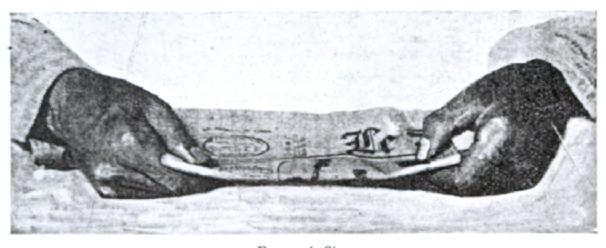1878-1946
Jules Froment was Professor of Medicine at Lyons, and devoted his life to neurology, combining diligent observation, a philosophical approach and debating skill.
Graduating in 1906 with a thesis on disease of the heart in thyrotoxicosis, he remained at Lyons until the Great War. After a year at the front, he joined a nerve injuries unit at Rennes, and later was at Paris with Babinski. During this time he evolved a series of tests for nerve dysfunction, the best known being his sign of ulnar nerve weakness; another was loss of the hollow of the anatomical snuff box in radial nerve injury.
After the war he ran a Red Cross Hospital in Lyons, and the encephalitis epidemic of 1918-1922 provided another intellectual challenge. In 1926 he nearly died as a result of being severely injured by one of his patients.
Froment pointed out the difference between a pinch grip and grasping, both of which are impaired by a low ulnar nerve palsy due to weakness of adductor pollicis. He introduced the following test to show this. Today it is used to assess flexor pollicis brevis.
Froment's Signe du Pouce: 1915
In order to demonstrate the disorder of the grip it is sufficient for the patient to take hold of any object between the thumb and other fingers. Two features may be observed: first, the weakness of the grip, and secondly the abnormal position of the thumb, although, while at rest, nothing would lead one to suspect it.
It is when a thin object is gripped that the faulty position of the thumb is most clearly evident. In practice, we hold out a folded newspaper to the patient; he is asked to pull it hard with the strong band and then with the affected hand, while we pull it fairly firmly away. This is what is observed: on the healthy side the thumb is in contact with the object gripped all the way along-the distal phalanx is extended or only slightly flexed. On the paralysed side the thumb resembles a flying buttress, the distal phalanx is markedly flexed and no matter what force is used it only holds the object by the very tip of the pulp. Very often there is a gap between the thumb and the newspaper, or, to be more exact, between the thumb and the side of the palm. (It is necessary to pull bard: the grip with the fixed thumb is only pathological when the grip is forcible).
This asymmetric attitude between the thumbs appears very dearly when the patient, taking the newspaper in both hands, pulls with different strength at both ends. This can clearly be seen in the photograph.



Tidak ada komentar:
Posting Komentar